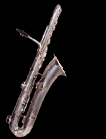Bass Sax Mouthpieces
All three of these mouthpieces can be used on a bass sax.
Left - Runyon Model 88 baritone sax mouthpiece
Middle - Conn Comet baritone sax mouthpiece
Right - Woodwind-LeBlanc bass sax mouthpiece
Photo by Paul Coats
|
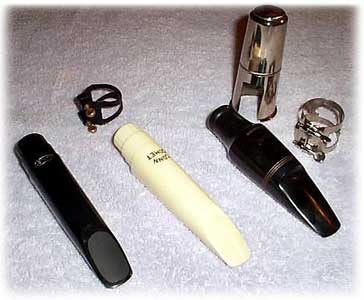 |
Obtaining reeds and mouthpieces for the bass saxophone is the biggest hinderance, after the logistics of moving the darn huge instrument, to playing it. FORTUNATELY, it is not necessary to use one of the few bass sax mouthpieces on the market today.
Many bari sax mouthpieces will work perfectly well, IF you have the facing lengthened from the usual 24mm - 25mm on out to about 29mm - 30mm. This allows the low end to respond well. The difference is quite striking, and there is no loss on the high end. The bass sax just needs more reed flapping!
Once you are using a bari mouthpiece, you will find that ordinary bari sax reeds work just fine. So, that is another problem out of the way.
When The Bayou Saxophone Ensemble received their new bass saxophone, we found we needed help in the mouthpiece and reed department. I remembered that bass saxophonist Bob K., from Dallas, used a modified Runyon/Conn mouthpiece. So, I called old friend Santy Runyon, and we set up an appointment at Santy's studio.
A little history here...as a young man, Santy had sat in with Red Nichols and the Five Pennies for a few months. This band featured the famous bass saxophonist Adrian Rollini, as well as Henry Bussey on trumpet. Adrian taught Santy a few bass tricks, such as using bari sax mouthpieces on bass (a commonpractice way back when), and stabilizing the D2 by adding the D palm key.

Photo by Paul Coats |
If you will notice, the neck pipes of the old Conns and Bueschers are of such a diameter that bari and bass sax mouthpieces both fit well. At the most, the cork may need to be sanded a little. |
As he had for Bob, Santy made us a bass sax mouthpiece using an old Conn Comet style blank. Runyon Products made these mouthpieces for the Conn Company many years ago. These are all gone now, but the Runyon Model 88 is almost identical internally, with only a slight cosmetic difference outside.
The 88 is in current production, and is the basis of the bass mouthpieces I am making for other players now. I recommend mouthpieces with .090"-.100" tip opening, with reeds in the #2 range.
What Santy did was start with a #7 bari facing, which is .093". Then he lengthened the facing from 24mm to 29mm. (I confirmed this with my own measurements.) That was all!
With a Fibracell Soft, or Rico #2, great results are had. Intonation is good, all the way up into the palm keys.
The real treat--the low end is strong and easy, not at all brittle. The tone is smooth, but projects when needed. Hey, if you have a bass and can't hear it, what is the point?
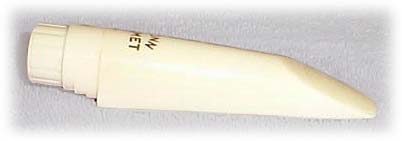
Conn Comet by Runyon Products. Photo by Paul Coats
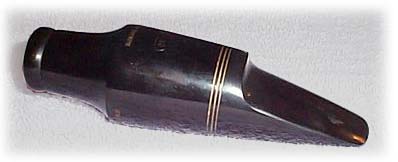
Woodwind -LeBlanc Bass mouthpiece. Photo by Paul Coats
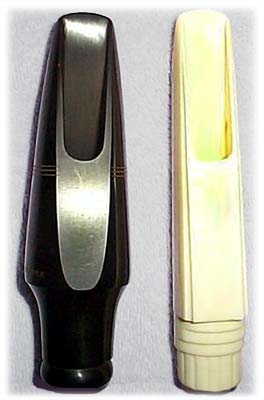
Left - Woodwind -LeBlanc Bass mouthpiece
Right - Conn Comet by Runyon Products.
Photo by Paul Coats
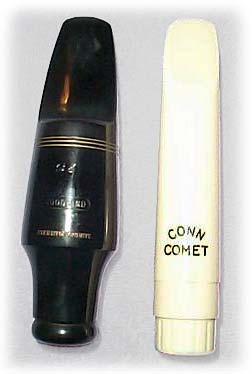
Left - Woodwind -LeBlanc Bass mouthpiec
Right - Conn Comet by Runyon Products.
Photo by Paul Coats
Going to tip openings larger than .100" does not help with volume--it simply requires more air, which is a problem with the bass--AIR! You really learn to plan where to breath!
With our original large chamber bass mouthpiece, the large chamber required the mouthpiece to be pushed on so far to tune the middle C, that the palm key notes went very sharp. But with the bari mouthpiece, it is pulled out to a more normal looking position on the cork, and the palm key notes play in tune.
Back to top of page.









